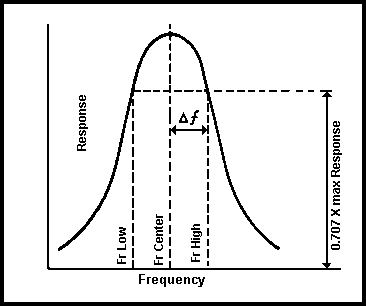
The ability of a tuned circuit to differentiate between a wanted frequency and an adjacent unwanted frequency is its 'selectivity'. This depends upon its Q; good selectivity requires high Q.

Fig 2.15. Resonance curve of parallel-tuned circuit
Fig 2.15 is a typical response curve (or selectivity curve) of a tuned circuit. The width of this curve, ie fh - fl, is known as the 'bandwidth' of the tuned circuit. Bandwidth can be defined at various levels, eg at the level where the response has fallen to 1/√2 or 0.707 (70.7%) of the maximum response (this is also known as the 'half-power point' or -3dB level). The ratio of the widths at -60dB and -6dB is known as the 'shape factor'.
The relationship between bandwidth and Q is:
![]()
where fr is the resonant frequency and 2Δf is fh-fr. From this it is seen that the lower f is, the lower Δf is, ie the bandwidth is less and selectivity is greater for a given value of Q. Similarly, the bandwidth is inversely proportional to Q; ie the higher the Q, the smaller the bandwidth.
The effect of several tuned circuits in cascade, eg in successive stages of an amplifier, is to reduce the overall bandwidth, ie increase the selectivity. This is particularly apparent in the region known as the 'skirts' of the selectivity curve where the bandwidth is greatest. In the majority of cases, the design aim is to increase the effective overall selectivity, but in some instances it is necessary to decrease the selectivity or increase the bandwidth. This is achieved by a 'damping resistor' connected across the tuned circuit; the lower the resistor, the greater its effect.